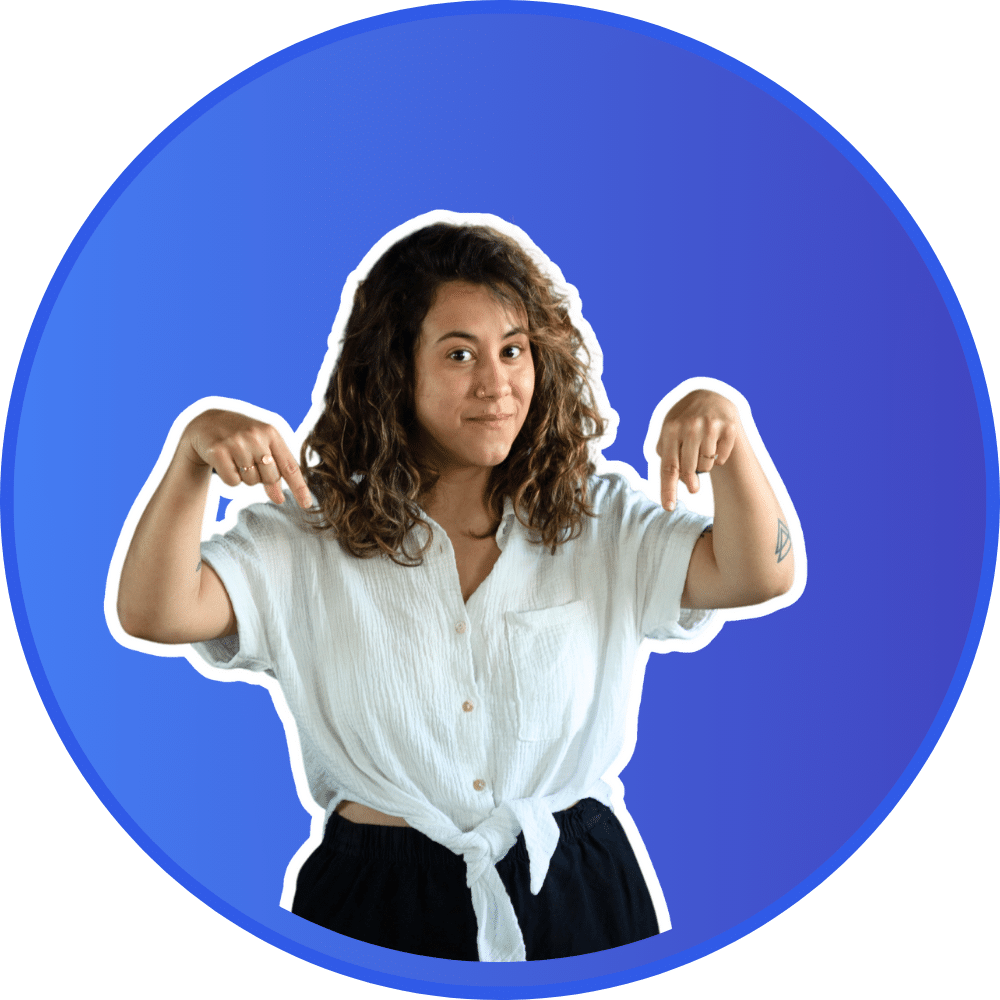LinkedIn isn’t just a professional social network, it’s the world’s largest free sales platform. 🌎
All the leads, all the prospects, all the sales you’ll ever need are on this platform. 🤩 And, with the right strategies, using LinkedIn for sales becomes child’s play.
➡️ On the program, the whole method for turning your account into a sales machine and boosting your results 🚀 :
- Why use LinkedIn for sales?
- Setting up a LinkedIn sales strategy on LinkedIn.
- 6 steps to build a LinkedIn sales strategy :
- Target your ideal potential customer.
- Optimize your profile.
- Publish on LinkedIn for sales.
- Send connection requests.
- Writing personalized messages.
- The importance of your copywriting (or art to sell on LinkedIn).
- Boost your LinkedIn sales strategy with automation.
Not using LinkedIn for sales means missing out on a major opportunity to turn your relationships into new customers and maximize your business impact on LinkedIn. 😬
Why use LinkedIn for sales?
Using LinkedIn for sales has become an essential strategy for sales professionals and sales teams wishing to develop their business. 👩🏻💻 It’s also a way of staying active in an environment where purchasing decisions are often made online.
🤯 With over 1 billion users, LinkedIn offers a huge B2B free online database (updated automatically in real time) and a powerful network of decision-makers, potential prospects and targeted business partners.
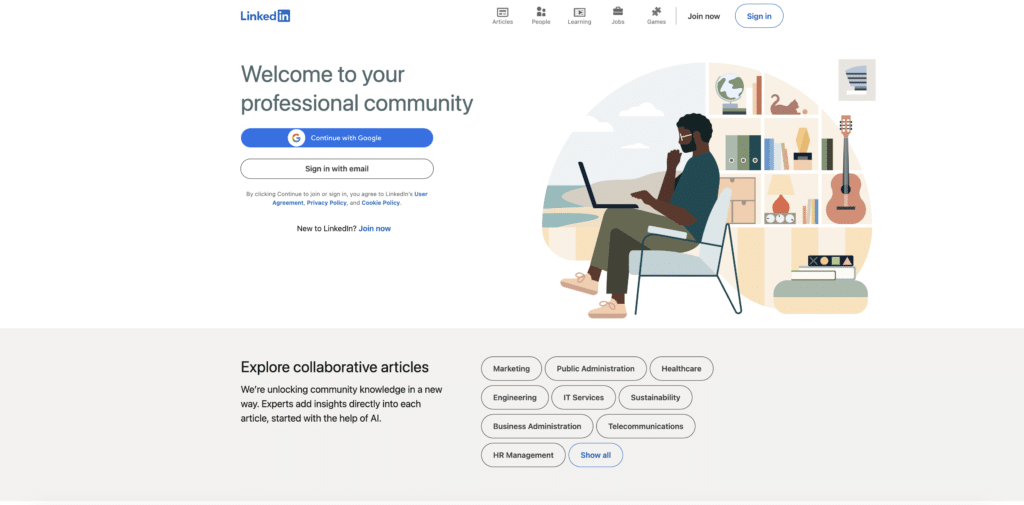
Unlike other social networks, LinkedIn is designed specifically for professional interactions 🗣️, enabling you to build stronger, more trusting relationships and partnerships.
⚙️ With precise targeting tools (including Sales Navigator if you have access to it) and tailored content techniques, you can reach your ideal audience (ICP sales) and engage in relevant conversations that lead to sales via LinkedIn.
Finally, LinkedIn offers increased visibility for experts who publish, boosting your credibility, your prospects’ trust and attracting sales opportunities. 🌟
👀 You’ll also be able to get real-time feedback from your customers, as well as “monitor” the competition to make the decisions that will drive your product forward. It would be madness to do without it.
How to build a LinkedIn sales strategy?
First, LinkedIn sales strategy needs to be adapted according to a larger market formula that includes four LinkedIn audience segments (applicable to all targets and activities). These include:
- 2-3% are ready to buy. 🟢
- 17% collect information because they know they have a problem. 🟡
- 20% become aware of their problem, but are not yet looking for solutions. 🟠
- 60% aren’t even aware they have a problem. 🔴
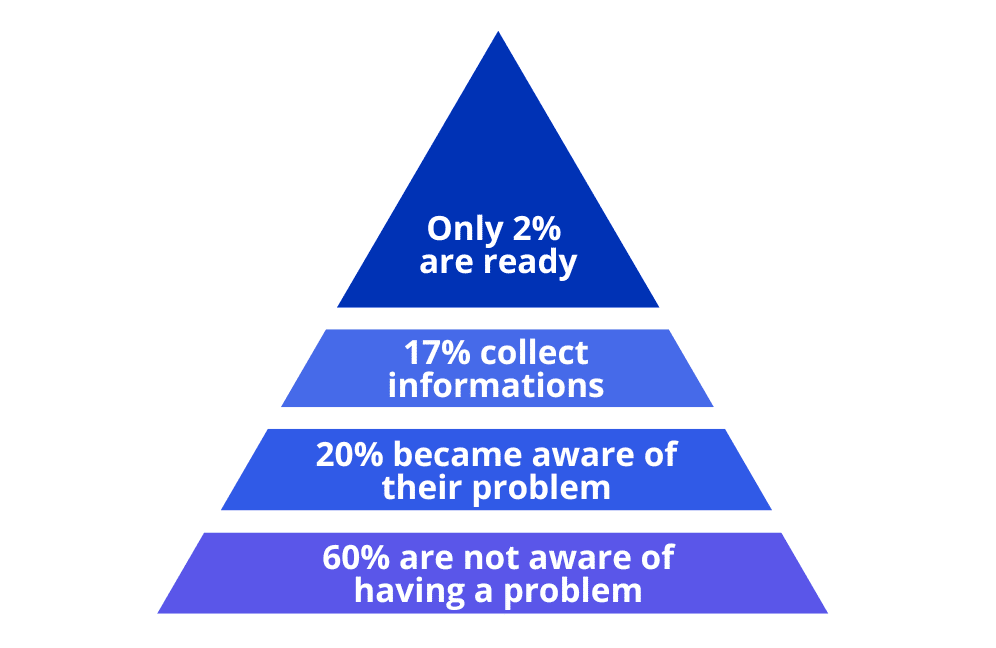
❌ Many LinkedIn sales strategies, as well as the related content that is published, focus solely on the 3% ready to buy (who are already getting bombarded with messages by your competitors, if you do the same, there will be no market share left).
What’s more, this considerably limits reach. ✅ What works best is to take an indirect approach for your LinkedIn sales strategy, by first building a network of connections and conversations.
To achieve this, you need to target all audience segments with the content you publish (TOFU-MOFU-BOFU) or with the structure of your messages.

Sales will come later (outside LinkedIn), when you’ve established a relationship of trust and offered solutions to your prospects’ problems, so they’re ready to buy when they’re sufficiently informed and convinced of your expertise. 💡
🌡️ In short, to be able to turn a stranger into a connection and then into a customer (outbound marketing or inbound marketing), you need to focus on the three Cs:
- Connection.
- Conversation.
- Conversion.
This approach allows you to position yourself as a problem solver, to convert and to set up, a funnel (or marketing funnel) to guide your potential prospects. 💸
LinkedIn is based on trust
LinkedIn is a platform built on trust ☘️ :
- LinkedIn (one of the most reliable platforms in the world).
- LinkedIn profiles (easier than a website).
Why? 🤔 All the essential information needed to determine a person’s expertise is visible on a LinkedIn profile: connections, shared connections, publication history, location…
All the opportunities are there and waiting for you. But, to succeed in your LinkedIn sales strategy and sell on LinkedIn, you’ll need to earn the trust of your audience.
📣 This will be easier than on other customer acquisition channels because you can talk directly with decision-makers, without having to bypass gatekeepers (assistant, agent, deputy…). ✨
LinkedIn is not only free, but LinkedIn lead generation conversion rates there are also 3 times higher than those achieved by running ads on other major advertising platforms (Google Ads) or social media (like Facebook).
6 easy steps to build a LinkedIn sales strategy
You’re about to discover all the steps you need to become a selling machine on LinkedIn. 🤑
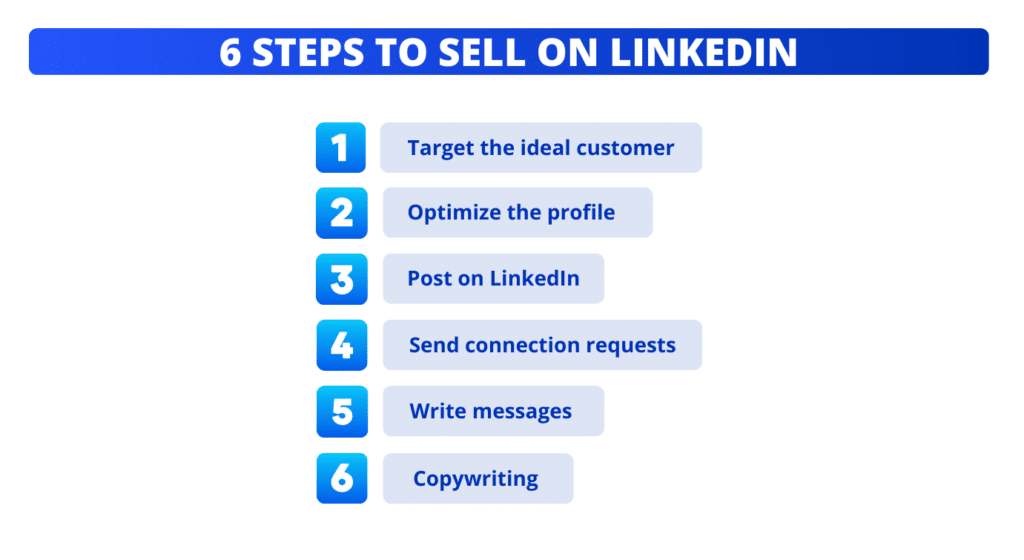
But first, let’s remind you of a prerequisite. 📍 You may not know it, but before using LinkedIn for sales, one of the best and first things to do will be to either :
- Empty your LinkedIn account (to keep only your relevant prospects and potential subjects). 😱
- Create another account specific to your company or brand (and keep your first account for your personal image).
Some people think that having lots of connections (including people who aren’t your target audience) multiplies the reach of content (because seen in other feeds)… But, that’s not a good idea if you want to build a successful LinkedIn sales strategy. ❌
These people will be less likely to see or engage with your posts, and if they do, their impressions will never lead to a purchase of your solution.
What’s more, if it’s not relevant to them, they may hide your content, which is a bad sign for LinkedIn’s publication algorithm, and therefore for your visibility. ⚠️
Now we’re ready to detail the 6 steps for a LinkedIn sales strategy, that really works.
LinkedIn search to target your ideal customer
It sounds obvious, you need to find customers on LinkedIn to launch your LinkedIn sales strategy. 🎯 To do this, you’re going to need to target precisely the type of consumer who’s going to buy from you.
You can use LinkedIn based on your own criteria (established on your buyer persona and according to the type of campaign), to do a good LinkedIn standard search all the prospect you need. 🔍
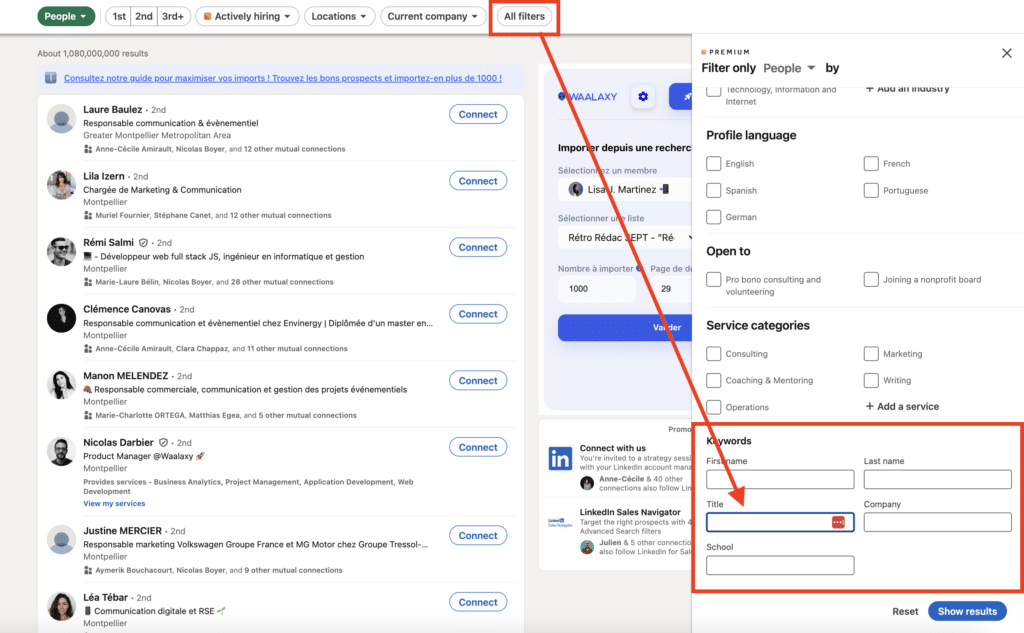
Then, you’ll reuse this list of prospects to send them connection request campaigns and messages on LinkedIn. 📲
However, you can also take out a paid LinkedIn Sales Navigator subscription, for more advanced search and filtering of your prospects according to your needs.
Here are the four main criteria people look for when prospecting on LinkedIn for sales: job title, industry, location, company size.
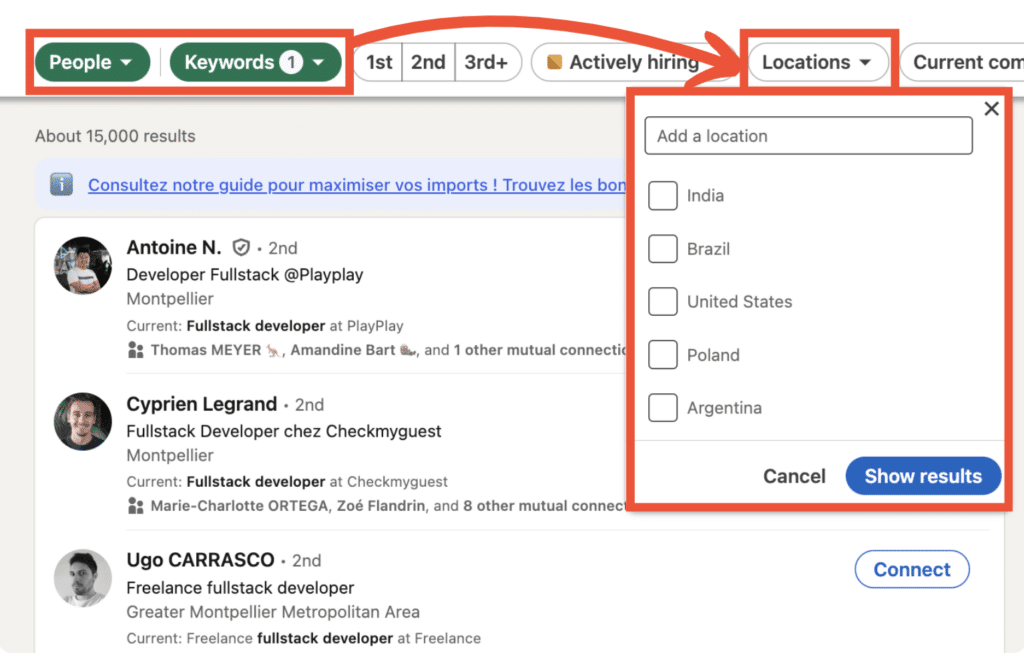
Optimize your LinkedIn profile for sales
Think of your LinkedIn profile as a landing page (or sales page) that absolutely must be optimized for raising LinkedIn outreach to your products or services.
So your profile has to be really good and demonstrate that you’re an expert in your field to attract as many potential prospects as possible. 🏆
Here are the key elements to optimize your profile (according to your LinkedIn sales strategy) :
- Profile photo: represent yourself in a polished, accessible way.
- Profile title (or LinkedIn Headline): Clearly describe your expertise and added value, and use the right keywords to increase your chances of being found and sold on LinkedIn.
- Summary: Highlight your skills, achievements and value proposition.
- Experience: Detail the concrete results you’ve achieved.
- Recommendations: Get testimonials from customers or colleagues to reinforce your credibility.
- Competencies: List key competencies to be found by the right prospects.
- Personalized URL : Make it easy to find your profile.
- Selection: Choose the content to promote your offer.

There’s a difference between a good, optimized, aesthetically pleasing profile and one specifically designed to generate leads. Either you know/can optimize your LinkedIn profile on your own, or you ask a professional to help you. 🫡
Publish on LinkedIn for sales
📆 Publishing regularly on LinkedIn is a powerful way to position yourself as an expert and generate sales opportunities.
For and effective LinkedIn content strategy, it’s important to follow a few best practices ✅ :
- Bring value : focus on sharing content that addresses your audience’s needs or problems. For example, tips, case studies or customer testimonials. The goal is to educate and engage, not just sell.
- Be consistent: publish regularly, but thoughtfully. LinkedIn’s algorithm favors LinkedIn users who are active and share relevant content.
- Use a variety of formats: mix articles, videos, infographics and carousels (visual publications generally generate more engagement), but also create more diverse content with LinkedIn Lives, podcasts, newsletter, e-book, etc.
- Engage with your network: respond to comments on your posts, interact with other publications and ask questions to encourage discussion.
- Subtle calls to action that encourage people to find out more, obtain a resource or exchange ideas (rather than pushing directly for a sale), to lead to more natural conversations.
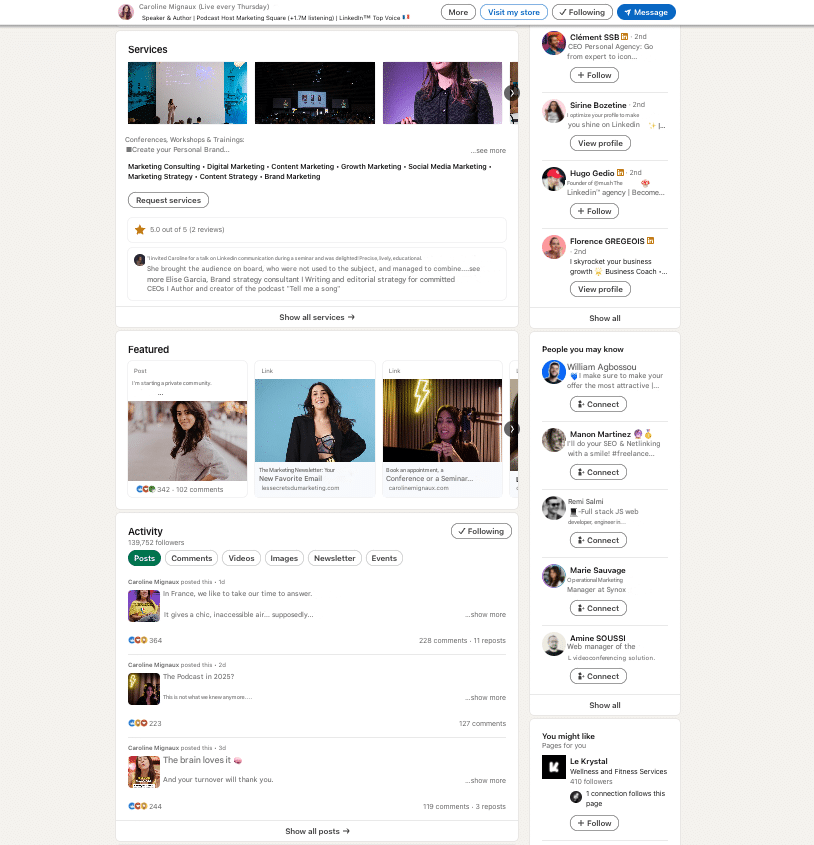
By taking this approach, you’re not just promoting a product, but building a relationship of trust that will encourage long-term sales. 🧱
Send LinkedIn connection requests
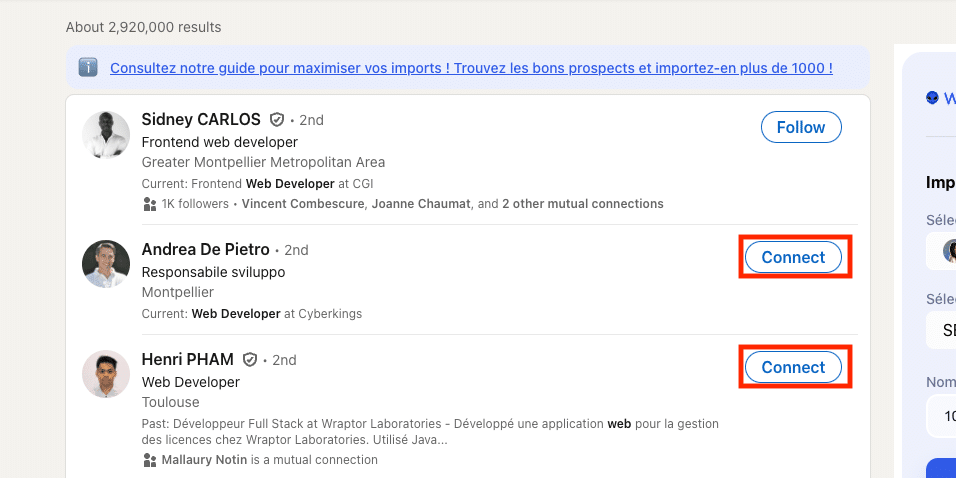
You can operate on two types of LinkedIn strategy: short-term (get customers immediately) and long-term (build relationships).
LinkedIn’s real potential lies in creating a lasting network (up to 30,000 connections targeted to your ideal market and profiles likely to buy from you), thanks in particular to connection requests. 📩
When sending out your requests, it’s important to position yourself as a problem solver (rather than offering your offer directly), and to adopt the right approach:
- Polite (courteous, respectful, interested in the sector).
- Curious (common ground or relevant content to share).
- Direct (clear and precise, subject to exchange ideas on…).
- Flattering (results, compliments, proposals for sharing or partnerships…).
The aim is to arouse the interest of as many prospects as possible, even if they aren’t immediately ready to buy. 🤷🏻♀️
Let’s say you send a hundred connection requests to the right people on LinkedIn and you have a good profile, then 30% will accept (as many ideal customers in your network), and 3% of them will say yes or buy.
Firstly, to make it easier for them to get to know and trust you. Secondly, to include them in a “continuous” educational exchange through a sequence of messages. 💬
💎 This allows you to position yourself as an expert, improve your offer and guide them through the funnel, right up to purchase.
Writing LinkedIn messages for sales
There are really five types of messages that work very well and that you can customize, then include in your sequences (alternate depending on the sequence and campaign chosen):
1. Connection request 🔗

2. Introductory message (sent 24-48h after acceptance of connection) which should be short and pleasant 🤗 :
- Show your appreciation, be grateful and personable by saying:
- Thank you for connecting {name}.
- I am delighted to have been able to connect with you.
- Thank you for accepting the connection request.
- Show interest with :
- I’d love to hear more about what you’re up to at some point.
- It’s even better that you’re local.
- I look forward to following your work.
- Start the elevator pitch:
- A little about me. I work with {target market} for {outcome}.
- I just helped {company} so I know the business.
- Nike and Adidas are among our clients.
- Finish:
- Let’s keep in touch.
- Let me know if I can recommend you for any skills.
- Perhaps we could meet.
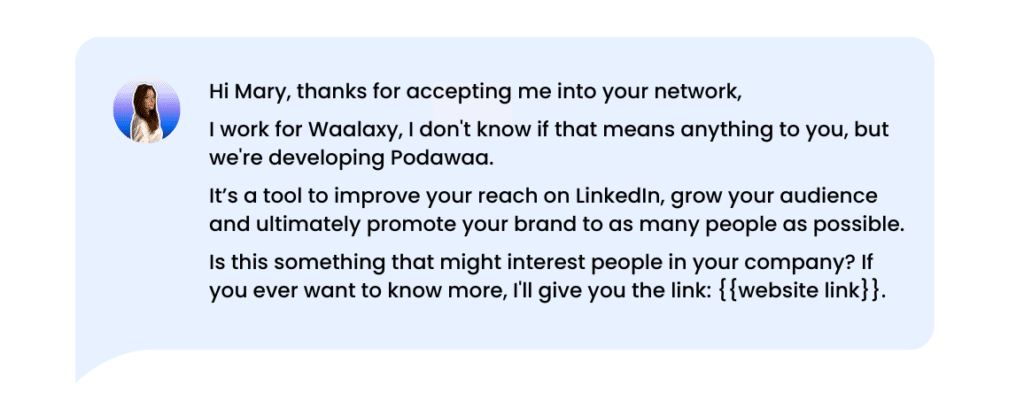
3. Value proposition and/or offer, to see if they have a need or a problem (to be sent in due course after several exchanges).
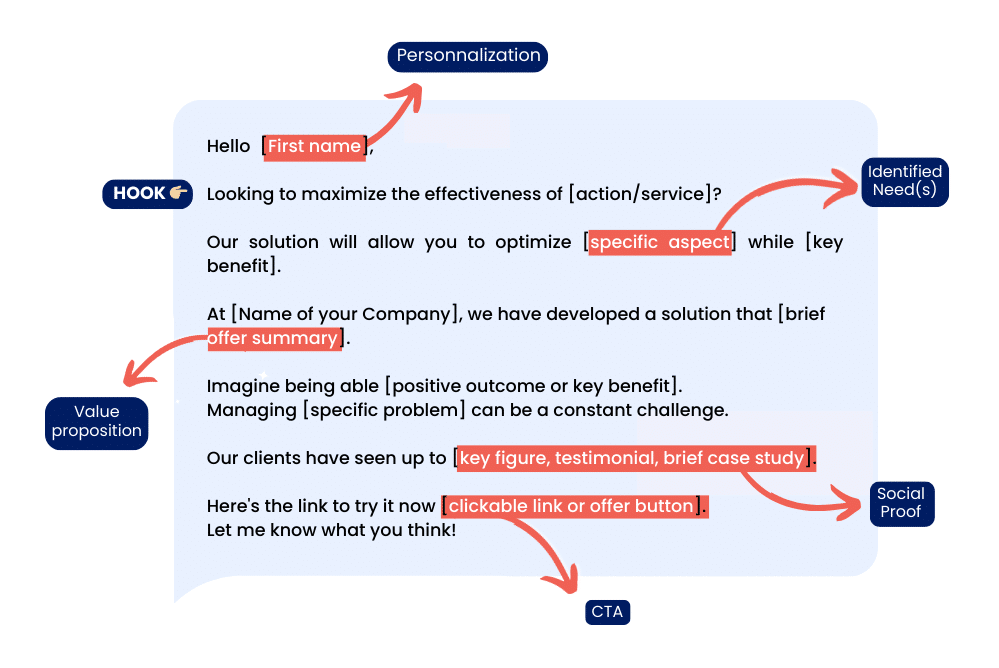
4. Nudge message to share content or send automated follow-up messages.

The limit not to exceed: after 5 messages sent without response, we leave the person alone for a few weeks or months and include them in the next campaign (if there is one).
The sequence of messages you adopt must lead your sales leads on LinkedIn to say yes to your offer, and for that, there’s a specific way to write them. 🤔
To get your messages read and to get positive responses, you need a LinkedIn content strategy that works and a distinctive copywriting style. ✍🏼
Importance of copywriting
The quality of your copywriting (approach, wording, style…) will make all the difference to your LinkedIn sales strategy success. 💁🏻♀️ Your approach, your wording, your copywriting, your sales pitch, your way to build trust will make the difference:
- Throughout your LinkedIn profile.
- When you talk about your offer.
- In your publications and messages.
Another tip: Structure your messages to solve a problem (rather than just offer a product/service), and broadcast it to a wide audience to reach a much larger part of your target market.
🌟 Having good copywriting can get your LinkedIn sales strategy off the ground :
- Grab the audience’s attention,
- Show your authority,
- arouse curiosity,
- Encourage confidence,
- Demo product or services.
- Encourage positive feelings.
If you can’t sell on LinkedIn, chances are it’s because of poor copywriting (which breeds a lack of confidence).👇🏼 There are different copywriting techniques:
- Disprove a myth to show your authority/expertise: you become a LinkedIn expert.
- Ask a question to highlight a problem.
- Name the result they want without the pain 😢.
- Indicate how to achieve such a result (thanks to your product or service).
- Tell them how it works/the signature process.
- List your product or service.
- Highlight any problems it solves/solutions provided.
- Highlight any time/money savings.
- Promise a deadline and/or a result.
- Make a compelling and attractive offer, relevant and engaging to the audience by solving a problem important to their business or at every possible point of frustration. It must be so attractive that your customers can only say one thing: “I absolutely need this”.
- Give a call to action.
🚨 Remember, when you complete your profile, write your posts or messages, it’s not about you, it’s about how you can help your target audience.
There’s a way to use LinkedIn for sales more easily and quickly, by automating all the steps we’ve just seen, and more. 🤖
Boost your LinkedIn sales strategy with automation
LinkedIn automation can help you to improve your LinkedIn sales strategy, making you ✅ :
- Save time,
- Increase the volume of committed leads to win more customers,
- Ensure continuous LinkedIn prospecting, without neglecting personalization.
- Nurture long-term relationships.
⚠️ Beware, sales automation can lead to failure, if you use it:
- Without having a solid LinkedIn sales strategy (and LinkedIn content strategy). ❌
- Without having a solid offer that really thrills potential customers. ❌
So take the time to build and test your offer well before you launch, it has to be perfect to turn your connections into conversions (the real difficulty).
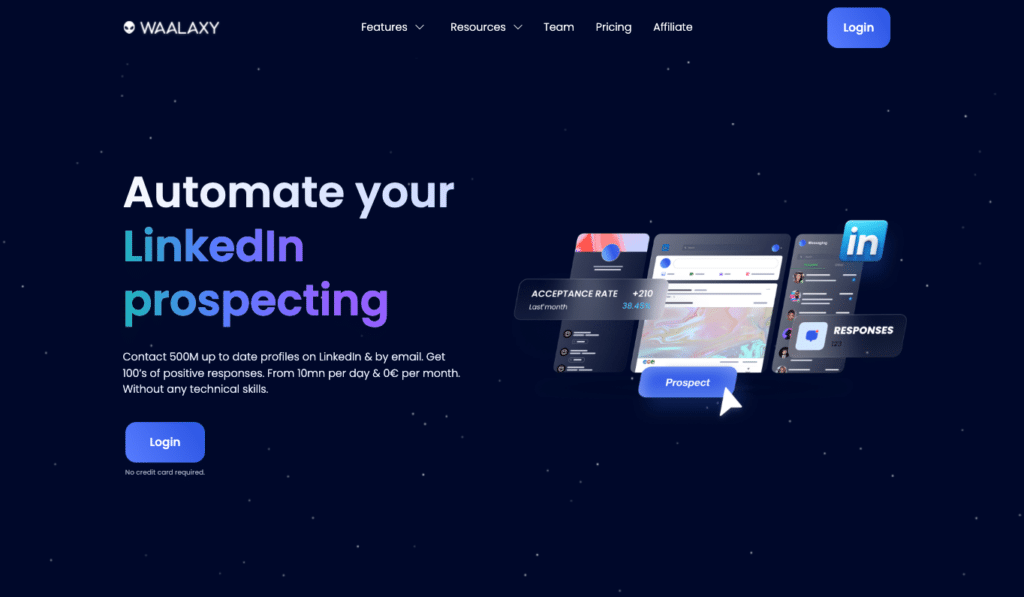
Auto-import of potential prospects
Apart from the standard search, there are more than 11 ways to import LinkedIn leads from LinkedIn, but only one to do it automatically: it’s auto-import. 🦾
The Waalaxy extension gives you access to auto-import, so you can retrieve a number of profiles to contact anywhere on LinkedIn (without needing to do a search! 😉
- Relationships.
- LinkedIn webinar participants or group members.
- Reactions to LinkedIn posts,
- Profiles that have commented on your post, sent an invitation or visited your profile.
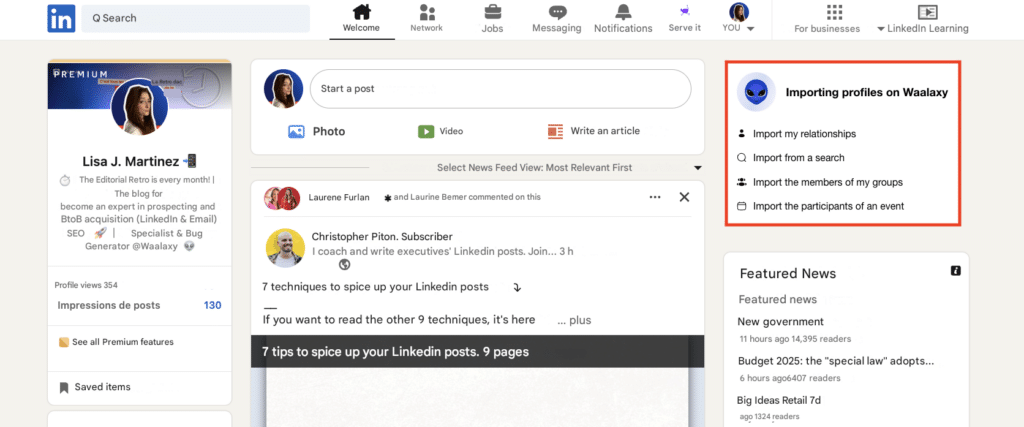
Then go to Waalaxy to retrieve the prospect list and re-sort it with Waalaxy filters. 🚀
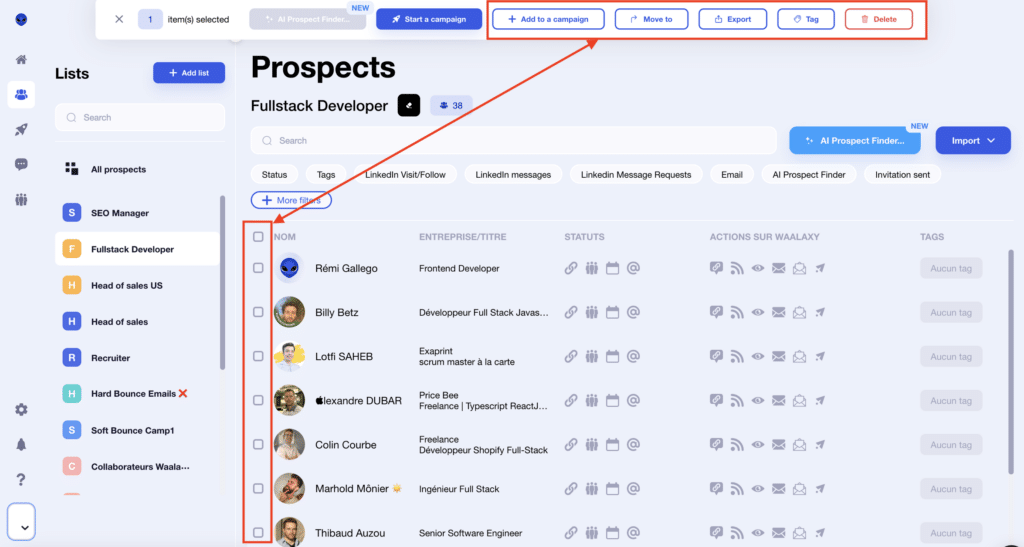
Contact a large volume of prospects
When your prospect list is ready, you can choose the automated action sequence you need from the template library. 📚
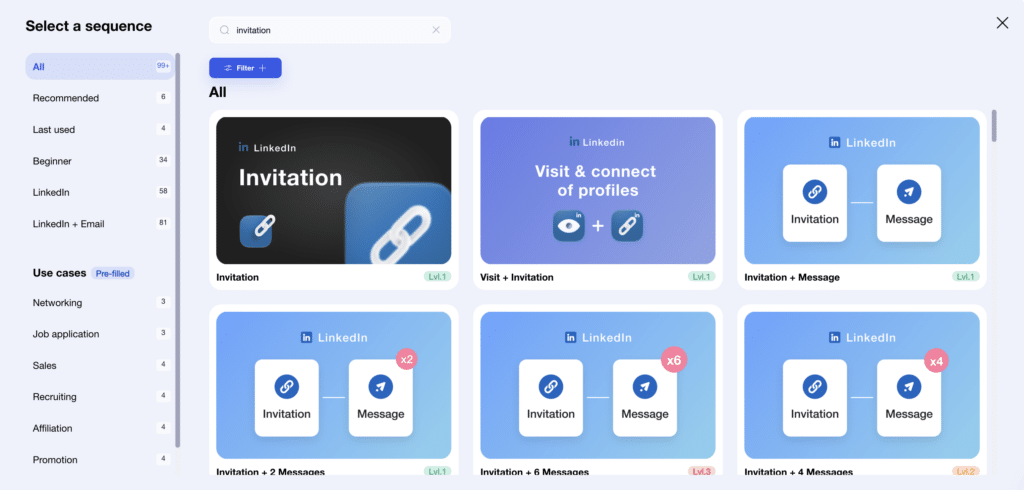
Among the automatable actions: profile visit, follow-up, connection requests (with or without personalized note), message request, messages, email finder, email…
We recommend that you automate the sending of your connection requests and messages, to avoid sending them manually to each profile on your 😮💨 list (Waalaxy sequence to use: Invitation + 1 to 3 messages).
Next, choose the type of message you wish to send, then write it (following the advice given above) and personalize it using :
- *️⃣ Personalization variables.
- 🕹️ Call-to-Action (CTA)
- 📸 Visual(s).
- 🔗 Attachment.
- ➡️ Other: GIFs, LinkedIn emojis, voice notes, links to external resources…
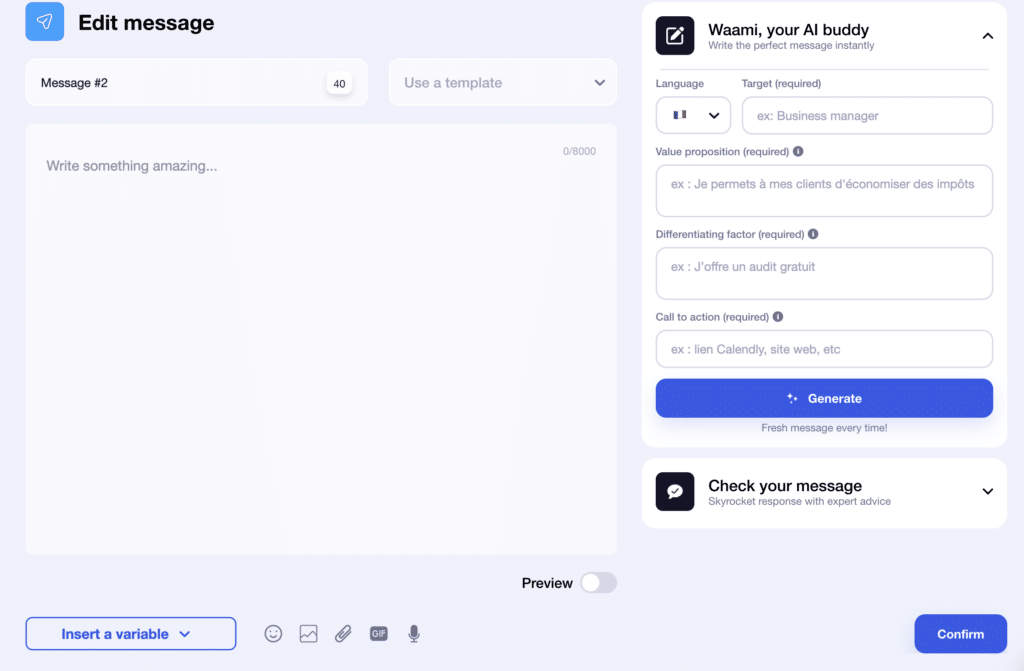
If you don’t know what to write, you can use our Waami AI writing wizard, which will help you write the perfect message with just a few pieces of information.
Finally, access the summary and launch your campaign! All you have to do is observe the results and manage the response to your actions.
With Waalaxy, it’s that easy! You really can’t miss it. 🔥
Lead management and follow-up
The campaign has been launched, and you can access the dashboard to analyze your results and performance indicators on Waalaxy. Good news, prospects have shown a lot of interest. 🤩
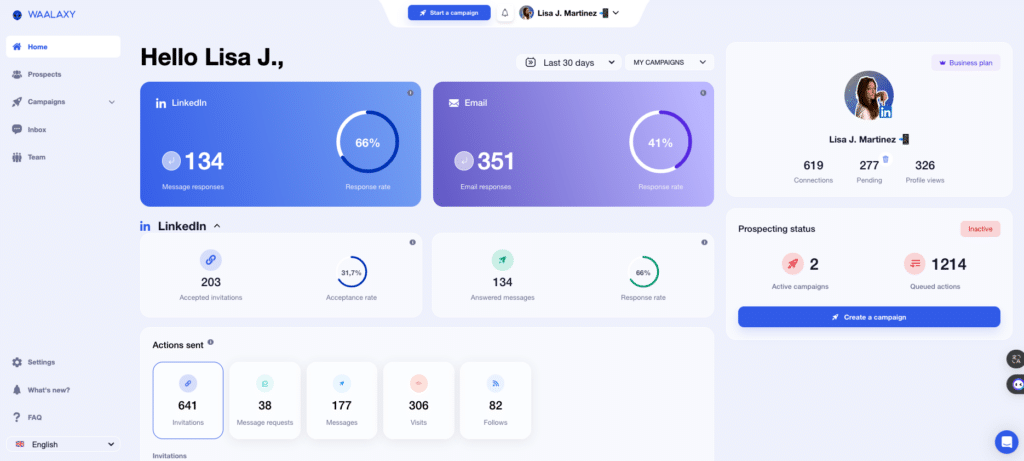
But, from there, how do you convert that interest into a sale? 🤔 This is the hardest part of LinkedIn: lead nurturing.
It’s a part reserved for managing, developing relationships and retaining leads, which takes place at the end of your entire sales process. 🌱
You’ll maintain the relationship with your prospects and customers, continuing to have regular interactions with them (and therefore launching further automated campaigns for your LinkedIn sales strategy).
To identify which prospects to focus on, you’ll essentially need to analyze the comments under your publications, but above all the replies to messages. 👀
To help you do this, use Waalaxy Inbox: LinkedIn messaging, but better.

Then you can use a lead scoring system to define a priority or “lead degree”, as well as tags so you can find them easily. 👌
Conclusion – LinkedIn Sales Strategy
In short, using LinkedIn for sales is much more than just a question of LinkedIn marketing, it’s above all a story of human relationships. 🤝
It’s a platform for building lasting relationships and showcasing your expertise while developing business opportunities. 🔥
🏆 Thanks to the targeted prospecting features offered by LinkedIn and an engaging content approach, you maximize your chances of success on LinkedIn while establishing long-term credibility.
And, if you boost your sales automation strategy, you’ll be able to: save time, find new customers, improve your marketing strategies and get more results. 🤖
Finally, we remind you that using LinkedIn for sales isn’t the only use case for the platform:
- Recruiting people to your team.
- Build and establish partnerships (referral partnerships).
- Find and select investors to present an investment opportunity.
- Diversify your content creation to showcase your expertise.
- Improve your social selling strategy (with physical or digital products).
Frequently Asked Questions (FAQ)
🏁 To conclude this guide for sales, here are the answers to the most frequently asked questions on the subject. 👇🏼
The Social Selling Index (SSI)
On LinkedIn, you have a way of knowing how well you’re using your account to create business opportunities: it’s the SSI, a score from 0 to 100 that measures your performance.
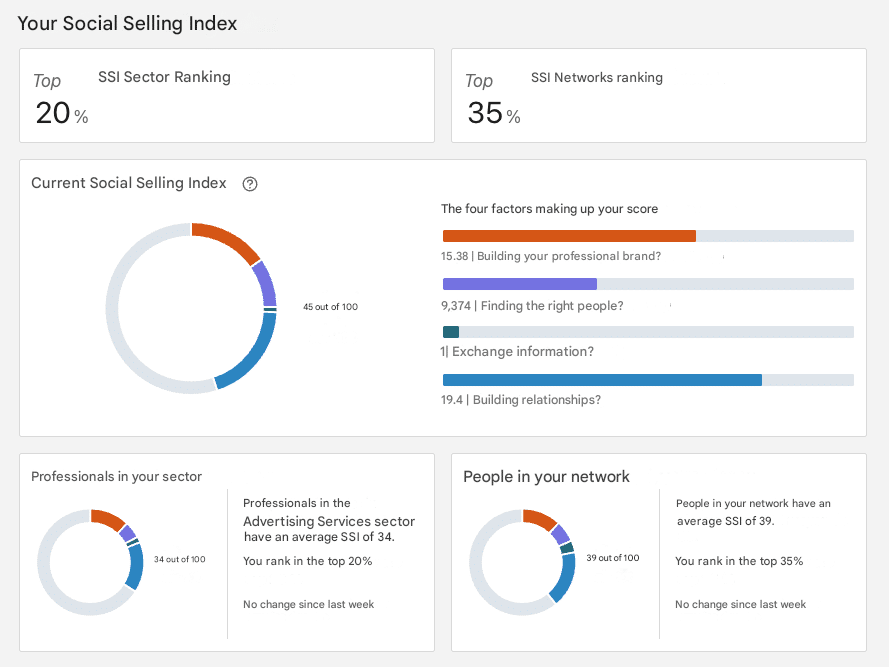
It will let you know if you’re connecting with the right people, if you’re not missing out on opportunities, and overall if you have a good LinkedIn sales strategy. ✅
Tips for your LinkedIn sales strategy
💡 We recommend even more actions to add to your LinkedIn sales strategy :
- Recycling and repurposing 🔄: Don’t just publish content once. Recycle it by republishing it in different formats (articles, infographics, videos) and send it by direct message (InMail) to targeted prospects to maximize its reach.
- InMail 📩: Use personalized private messages to reach prospects who aren’t yet connected directly. A well-written message focused on their specific needs can generate a more personalized and engaging interaction.
- LinkedIn Ads 📢: Sponsored ads on LinkedIn enable you to target a very precise audience based on demographic and professional criteria. They’re ideal for reaching highly targeted prospects with a hard-hitting message.
- LinkedIn Groups 👥: Joining LinkedIn groups related to your business or creating one allows you to connect with prospects interested in specific topics, exchange ideas and build your authority in your field.
By combining these LinkedIn sales strategies, you can expand your network on LinkedIn, engage prospects and increase your sales opportunities.🚀
You’re done! 🎬 You’ve got the whole method to use LinkedIn for sales, so don’t hesitate to give it a try. See you soon! 👽




